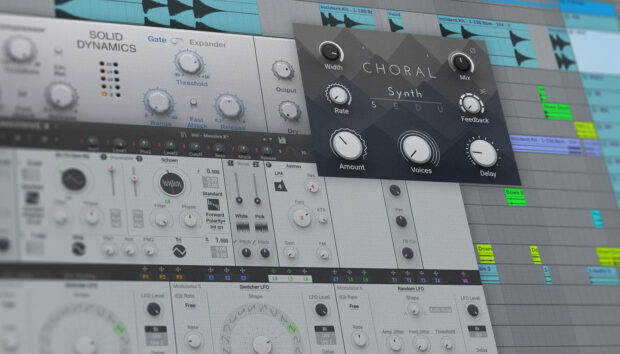
Electronic rock pioneer Gary Numan tells us about his current studio approach, while his longstanding producer Ade Fenton explains his attitude to sound design.
DJ/producer Ade Fenton began his rise to notoriety in 2004 with a series of techno releases on his own labels Advanced and Perverter. A jack of all trades, he quickly progressed to production, eventually resulting in an unlikely partnership with electronic rock pioneer Gary Numan.
With Fenton as producer on Numan’s 18th studio album Jagged (2006), the duo went on to forge an increasingly successful alliance, collaborating on Fenton’s own Artificial Perfect album and critically acclaimed releases from Numan such as Dead Son Rising and Splinter (Songs from a Broken Mind), his first album to reach the UK Top 20 in over 30 years.
Following a four-year absence, Numan resurrected his working relationship with Fenton prior to writing his latest studio album, Savage (Songs from a Broken World). Released in September, it has crashed into the UK Top 5, while Fenton’s stock continues to rise with upcoming scores for the horror film, Nails, and two TV series, Kiss of Death and Eight Days That Made Rome. Here, Fenton and Numan discuss their work together as well as the collaboration on the most recent album.

A meeting of minds
I’ve known Gary for many years and first became friends through a mutual friend of his wife, Gemma. I’d always had a love for dark, industrial electronic music, and just by chance was partying at Gary’s house when he was writing the album Jagged.
Gary had heard some stuff I’d been working on that was in an industrial/Nine Inch Nails vein. He liked it, gave me a track to work on, and since then we haven’t looked back. It’s funny how it came about, because Gary doesn’t get techno or dance music at all, so for him to even ask me in the first place was a real stab in the dark.
Preparation for savage
After Splinter we decided to take a break, which only made us realise that we’re at our best when working together. He gave me some demos he’d been working on, including a song called “Bed of Thorns”, and it all fell back into place very quickly. I can’t really explain it, but he just allows me to do what I do. I’ve been a Gary Numan fan since 1979 and tend to look at his music from a fan’s point of view as well as a producer, so I’ll usually do something that I like and he’ll like it too.
I’m not precious about it, they’re Gary’s songs and it’s my job to make them sound as good as possible. For Savage, I thought his voice needed to be at the top of the mix. He’s a bit like David Bowie – you can’t mistake Gary Numan’s voice for anybody else. We’ve also tried to use the same high string sounds that he used on early albums like The Pleasure Principle and Telekon, but in a more contemporary way.
The working process
For the majority of tracks, Gary tells me the feel he wants and to go off and make it better. Because Splinter had been so well received, you feel this pressure to go up another notch, but it started to flow really quickly, much faster than the previous albums we’d worked on. We thought the album needed to not just follow on from Splinter, but feel like a progression, so one of the things we decided to do was to make it more electronic.
All of the drums on Savage are electronic – there are no acoustic or acoustic-sounding drums at all. Once the lyrical content started to flow and Gary had decided on the ‘concept’, lots more ideas on the production front started to flow. For example, we used a lot of war-type tribal drums and thunderous cinematic toms to get that feeling across of the music being post-apocalyptic.
It all began with you
The sound at the start of the track “It All Began With You” came from the Access Virus, but heavily processed. When I was going through patches on the Virus I came across this sound and thought, ‘God I like that, it’s so weird’. It’s an arpeggiated sound, but with a bit of jiggery pokery started firing off all over the place. Gary sent me an email about it, saying he wasn’t sure whether the random arpeggiator things was genius or complete shit – I just sent an email back saying that it’s genius.
A thorny issue
The Arabian vocal lines on tracks like “Bed Of Thorns” derive from lots of different places. There’s an Ethno World plugin that has some lovely Arabian vocal samples, but it’s quite difficult to find stuff that sounds really good. I searched as many sample libraries as I could and processed them quite heavily through my Eventide Eclipse to try and detune them, although the vocals are already in quite a strange key anyway.
Originally, we had a call to prayer sample on one of the bonus tracks, “If I Said”, but we decided to take it out in the end even though it fitted beautifully with Gary’s chord progression. A bit of a commotion started to surface with Gary having to explain why he was using the Middle Eastern typeface and post-apocalyptic imagery, so although the album was mastered on May 24, we decided to take it out on the evening of May 23.
Savage sound design
I guess you’re looking to achieve some kind of unique sound that no one else will have heard before. That doesn’t necessarily mean it has to be the greatest sound you’ve ever heard, but if you can get something to work musically that is as unique as a sound can be, that’s sound design. For Savage, the song “Ghost Nation” has loads of sound design and, to me, one of the most exciting parts of production is when you get something that’s really working and you’re not just throwing it in for the sake of it.

Sound design
I mix a lot of analogue gear, digital and software. For a lot of the sound design stuff, I’m using a couple of analogue hardware synths from a boutique British synth company called Analogue Solutions. A lot of the sound design originates there and just gets processed to hell, either through outboard gear or, most of the time, plugins.
There’s one new Native Instruments plugin called FORM, which is a fantastic sampler. We used it to death on Savage. I’d record perhaps two hours worth of random weird sequences from the Analogue Solutions synths, firing random stuff into the computer, then I’d chop it all up to see if I could make those sounds even better – that’s where FORM became so useful!
I used MASCHINE on Savage quite a bit and the quality of sounds has continued to get better and better, but one of the instruments used most on Savage, and pretty much everything I do, would be REAKTOR. Most of the time when I’m using REAKTOR I don’t even know why I’ve opened it in the first place, but I always know I’m going to get something great out of it. When I’m looking for something random or really extreme, I’ll use REAKTOR. I don’t even think to myself that I need a certain kind of sound, I’ll just see what I can find and almost 100% of the time I’ll open it, choose a plugin and find something amazing.

Ade’s hardware
I’ve got two Access Virus Tis, because a lot of the classic Gary Numan sounds originate from it, and an Analogue Solutions Leipzig-S, which was given to me by a splendid chap called Tom Carpenter from Analogue Solutions. He’s been very kind to me over the years and gave me this Leipzig-S, which is a semi-modular analogue synth with an 8-step sequencer on it and two oscillators. It’s amazing for bass lines and getting weird stuff out of.
I’ve also got an Analogue Solutions Vostok Deluxe, which is the most mental thing you’ve ever heard. I bought it after I started Savage, but it makes quite a few appearances. Again, it’s a little bit like using REAKTOR; I’ll just sit down for hours and see what it can do. Other synths I’m using include the Elektron Analog Keys, a black Waldorf Blofeld and a couple of MFB Urzwerg Pros. I’ve always loved step sequencers, and prefer the hardware ones because you can get more random stuff going.

Gary numan on savage
I had the feeling with Splinter that my work with Ade had peaked. It was the third album we’d done together and it had gone really well. People were saying Splinter was the best album I’d ever made, so I thought we probably wouldn’t be able to do a better one as a team. For a while I thought about doing it all on my own, because I used to, but that wasn’t working out.
I did the song “Bed of Thorns”, which ended up on the Ghost In The Shell soundtrack album, but that was just a demo. Paramount called me in to potentially add an electronic element to the score, so I sent them “Bed of Thorns” just to give them an idea of what I’m doing now. I didn’t hear back and thought nothing of it, then a few months later I got an email saying we really love the track and want to put it on the album. I was like, “that’s just a demo!”. I did it in about two days, and they wanted to put that version out!
Working with Ade again
It was a good decision, because he’s really clued up. He’s not just clever technically, but creative and comes up with really great parts. We worked together really well for the first three albums, but there was a lot of arguing. We’re both quite passionate about our opinions, so there was definite friction, but with Savage there was none at all. Part of that is because we understand each other much better now. When he goes off in a direction I hadn’t intended, I’ll let it go, because often it’s a good tangent, and if after two weeks I still don’t like it, we’ll bring it back.
He’s very fast, very diligent and always on it. The stuff comes back very quickly with a huge amount of parts and ideas, and beautifully recorded. Nathan Boddy mixed the album to a much greater degree this time and we had a little production line going. I would write the songs and produce them up to a point that gave Ade guidance, then he’d work on something really cool and give that to Nathan to start the premixes.
For the final part, we went to Nathan’s place in London and went through the final mixes, then Matt Colton did the mastering, and he’s brilliant. You take something to Matt and think, I’ve got you this time – this is perfect, what are you going to do with that? Then he listens for a minute, turns his big dials and every time it’s better.
photo credits: Tom Ham















